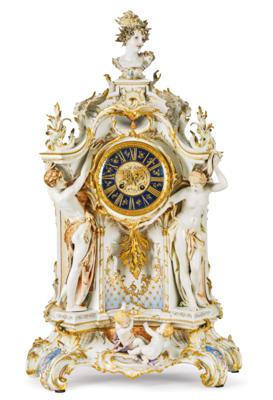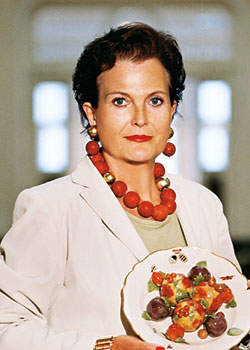A Porcelain-Clock Case by KPM Berlin, Late 19th Century,

with clock movement in white with gold highlights and delicate floral painting, the architectonically moving clock case with wide and narrow gilt edging, gold décor and fine garlands of flowers on light blue ground, surmounted by a female bust with light blue eyes adorned with a flower garland of flowers on the head and blossoms on the décolleté as spring goddess “Flora”, from the pedestal hangs a saddle cloth with sun face in relief, golden rays and light purple tassel, below it a gable with leaf rocailles, at the ends of each a fire-breathing dragon winding up with its wings and tail to the clock roof, the cornice is held on the left side by an atlas, dressed with lion pelt around his hips and light purple drapery, on the right side a caryatid carries the weight with her shoulders and supports the upper cornice area, both figures use their clothes both for protection and to have better grip when supporting the cornice. Below the movement a faun head with beard and horns, open mouth with teeth and a demonic look, the caryatid soothingly lays her right hand on his forehead. In the niche, under the faun’s head, golden lattice-work with stippled flowers and golden flowers with leaf rocailles. In the foreground in the base, a naked boy sitting and one lying on light purple cloths, both pointing with their hands to the faun’s face fearfully. In the background, a hollow with light purple and gold scale paintings. Four volute feet with rich gold leaf rocaille and fine floral festoons, gold-heightened shells in the intermediate parts. Movement with front glass cover and “bronze doré” relief rim, black dial with golden Roman numerals, golden bouquets and golden hands in relief, the mid-section with white porcelain plate with openwork laurel branches and two scythes as a reference to Chronos, the god of time, rim with foliate rocailles, the reverse side also with glass cover, height 97 cm, width 58 cm, depth 26 cm, small restored areas, with pendulum and key, movement unchecked
underglaze blue sceptre mark, late 19th century, first mould in 1888, designed and modelled by Paul Schley with the assistance of Burckhardt Apel and Hinke (Ru)
Lit.: Franca Dietz, Die Sammlung Hassan Sabet, 2013.
Due to its size and the complexity of its individual components, the present clock is a technical and artistic masterpiece in porcelain. This extremely labour-intensive and expensive clock has been exhibited several times by the manufactory as a magnificent showpiece.
In 1888, a model of the clock was shown at the German National Arts and Crafts Exhibition in Munich, p. 243.
1893: a historical photograph of the sales rooms of the KPM store, p. 243.
1908: historical photograph with the pendulum hanging from the mouth of the faun’s face.
In 1904, the clock case with movement was shown at the World’s Fair in St. Louis. There are only three known designs of this large-sized clock case.
Esperta: Ursula Rohringer
 Ursula Rohringer
Ursula Rohringer
+43-1-515 60-382
ursula.rohringer@dorotheum.at
05.05.2022 - 14:00
- Prezzo realizzato: **
-
EUR 74.240,-
- Stima:
-
EUR 30.000,- a EUR 50.000,-
- Prezzo di partenza:
-
EUR 30.000,-
A Porcelain-Clock Case by KPM Berlin, Late 19th Century,
with clock movement in white with gold highlights and delicate floral painting, the architectonically moving clock case with wide and narrow gilt edging, gold décor and fine garlands of flowers on light blue ground, surmounted by a female bust with light blue eyes adorned with a flower garland of flowers on the head and blossoms on the décolleté as spring goddess “Flora”, from the pedestal hangs a saddle cloth with sun face in relief, golden rays and light purple tassel, below it a gable with leaf rocailles, at the ends of each a fire-breathing dragon winding up with its wings and tail to the clock roof, the cornice is held on the left side by an atlas, dressed with lion pelt around his hips and light purple drapery, on the right side a caryatid carries the weight with her shoulders and supports the upper cornice area, both figures use their clothes both for protection and to have better grip when supporting the cornice. Below the movement a faun head with beard and horns, open mouth with teeth and a demonic look, the caryatid soothingly lays her right hand on his forehead. In the niche, under the faun’s head, golden lattice-work with stippled flowers and golden flowers with leaf rocailles. In the foreground in the base, a naked boy sitting and one lying on light purple cloths, both pointing with their hands to the faun’s face fearfully. In the background, a hollow with light purple and gold scale paintings. Four volute feet with rich gold leaf rocaille and fine floral festoons, gold-heightened shells in the intermediate parts. Movement with front glass cover and “bronze doré” relief rim, black dial with golden Roman numerals, golden bouquets and golden hands in relief, the mid-section with white porcelain plate with openwork laurel branches and two scythes as a reference to Chronos, the god of time, rim with foliate rocailles, the reverse side also with glass cover, height 97 cm, width 58 cm, depth 26 cm, small restored areas, with pendulum and key, movement unchecked
underglaze blue sceptre mark, late 19th century, first mould in 1888, designed and modelled by Paul Schley with the assistance of Burckhardt Apel and Hinke (Ru)
Lit.: Franca Dietz, Die Sammlung Hassan Sabet, 2013.
Due to its size and the complexity of its individual components, the present clock is a technical and artistic masterpiece in porcelain. This extremely labour-intensive and expensive clock has been exhibited several times by the manufactory as a magnificent showpiece.
In 1888, a model of the clock was shown at the German National Arts and Crafts Exhibition in Munich, p. 243.
1893: a historical photograph of the sales rooms of the KPM store, p. 243.
1908: historical photograph with the pendulum hanging from the mouth of the faun’s face.
In 1904, the clock case with movement was shown at the World’s Fair in St. Louis. There are only three known designs of this large-sized clock case.
Esperta: Ursula Rohringer
 Ursula Rohringer
Ursula Rohringer
+43-1-515 60-382
ursula.rohringer@dorotheum.at
|
Hotline dell'acquirente
lun-ven: 09.00 - 18.00
kundendienst@dorotheum.at +43 1 515 60 200 |
| Asta: | Mobili e anitiquariato, vetri e porcellane |
| Tipo d'asta: | Asta in sala con Live Bidding |
| Data: | 05.05.2022 - 14:00 |
| Luogo dell'asta: | Wien | Palais Dorotheum |
| Esposizione: | 30.04. - 05.05.2022 |
** Prezzo d'acquisto comprensivo di tassa di vendita e IVA
Non è più possibile effettuare un ordine di acquisto su Internet. L'asta è in preparazione o è già stata eseguita.
